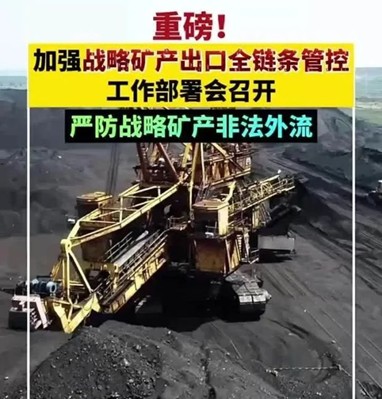Trade Talks, Real Moves: PRC Locks Down Critical Minerals Behind the Scenes
By:

Executive Summary:
- Beijing has formally escalated its critical minerals strategy by launching a coordinated, multi-agency campaign to enforce full-chain control over rare earth and strategic mineral exports, mobilizing more than a dozen central and provincial agencies to supervise mining, processing, licensing, and export operations.
- Authorities are targeting foreign circumvention and domestic collusion and framing this crackdown as a national security imperative. Joint operations aimed at dismantling smuggling networks and third-country transshipment routes are being run by the Ministry of Commerce, the Ministry of State Security, and China Customs.
- At the same time, the People’s Republic of China (PRC) is accelerating upstream resource development, expanding domestic exploration to ensure long-term supply for strategic industries and tightening its grip on a sector that underpins both its economic security and external leverage.
On May 12, the same day Washington and Beijing released the “Joint Statement on U.S.-China Economic and Trade Meeting” following trade talks in Geneva, regulators in the People’s Republic of China (PRC) convened over a dozen ministries and provincial authorities to discuss critical minerals (The White House, May 12; People’s Daily, May 13). Officials gathered in Changsha, Hunan Province, where they agreed to escalate enforcement across the entire strategic mineral export chain—from mining and processing to licensing and customs inspection. That same day, the Ministry of Commerce and the Ministry of State Security launched an interagency crackdown on smuggling, citing “collusion between foreign entities and domestic lawbreakers” (发现一些境外实体与境内不法人员相互勾结) and pledging further operations (MOFCOM, May 12; Xinhua, May 13).
The meetings marked a tightly choreographed push to secure every link in the critical mineral value chain through regulation, enforcement, and upstream development. This three-pronged campaign, led by top officials from over a dozen ministries and key resource-rich provinces, signals a shift from regulatory signaling to institutionalized, full-spectrum control. It reflects an escalating assertion of state power over a foundational industry, with direct consequences for global supply chains, export-reliant manufacturers, and the next phase of tariff diplomacy. While not explicitly framed as retaliation, this posture sends a clear signal to trading partners: Beijing’s grip on the global critical minerals market is tightening, and it will be used to defend core national interests.
National Coordination of Full-Chain Control
The deployment meeting in Changsha province on May 12 marked a major escalation in the PRC’s export control strategy, formally mobilizing a national cross-departmental campaign to enforce “full-chain control” (全链条管) over strategic mineral exports. Convened by the State Export Control Work Coordination Mechanism Office (国家出口管制工作协调机制办公室), the meeting brought together over ten central ministries, including Commerce, Industry and Information Technology, Public Security, State Security, Customs, and the State-owned Assets Supervision and Administration Commission, along with local officials from mineral-rich provinces.
The meeting laid out a detailed compliance and enforcement mandate. National and local authorities are required to supervise every segment of the critical minerals supply chain, from mining and smelting to transport, export, and re-export. The meeting also called for enterprise-level compliance tracking, daily supervision, and the creation of region-wide ledgers of operators engaged in strategic mineral activity.
Cross-Agency Enforcement Against Foreign-Domestic ‘Collusion’
The Ministry of Commerce has publicly framed this intensified control push as a direct response to recent violations. In a separate statement, the ministry announced that since Beijing implemented export controls on heavy rare earths earlier this year, authorities have uncovered instances of “overseas entities and domestic lawbreakers” attempting to circumvent restrictions through smuggling and transshipment via third countries (X/@MOFCOM_China, May 13). These discoveries prompted an earlier meeting in Shenzhen on May 9, also convened by the State Export Control Work Coordination Mechanism Office.
This meeting, a precursor to the Changsha deployment, initiated a high-pressure enforcement campaign, with the Ministry of Commerce pledging further operations to follow and reiterating that export control enforcement will remain aggressive and expansive. According to a ministry spokesperson, the campaign is a response to attempts by foreign actors to bypass export controls through third-country transshipments and collusion with domestic networks (Xinhua, May 13). Enforcement bodies—including the Ministry of State Security, the General Administration of Customs, and the State Post Bureau—have initiated port inspections, joint case reviews, and network mapping of smuggling operations. These steps indicate that the PRC’s export control regime is moving from regulatory articulation to active interdiction, placing additional pressure on the United States and other countries reliant on these materials.
Expanding the upstream resource base
At a separate internal meeting that took place recently, the Ministry of Natural Resources announced the acceleration of “strategic operations in mineral exploration breakthroughs” (找矿突破战略行动), highlighting the need to enhance domestic resource security amid global uncertainty (China Securities Journal, May 13). This initiative aims to increase the availability of rare earth and critical mineral resources within the PRC, ensuring a steady supply base for the country’s defense, electric vehicle, and high-end manufacturing industries. This upstream expansion drive parallels the enforcement and control measures already in place, reinforcing Beijing’s long-term leverage in global mineral markets.
Conclusion
As trade talks opened in Geneva, Beijing moved in parallel to intensify its campaign for strategic control over rare earths and critical minerals—a domain where it holds disproportionate global leverage. While high-level diplomacy conveyed flexibility on relaxing restrictions, domestic actions delivered a more decisive message. The coordinated meetings in Changsha, Shenzhen, and other jurisdictions marked the formal consolidation of export enforcement as a national security imperative, embedding rare earth and critical mineral control into the architecture of Beijing’s broader deterrence strategy.
The message was not subtle. Even amid formal engagement, the PRC is locking in and expanding control over raw materials vital to U.S. defense and high-tech industries. And it is doing so with deliberate sequencing. Beijing’s latest moves represent the opening phase of a coordinated campaign to fortify its economic perimeter and highlight potential retaliation tools it may deploy if U.S. pressure intensifies.



